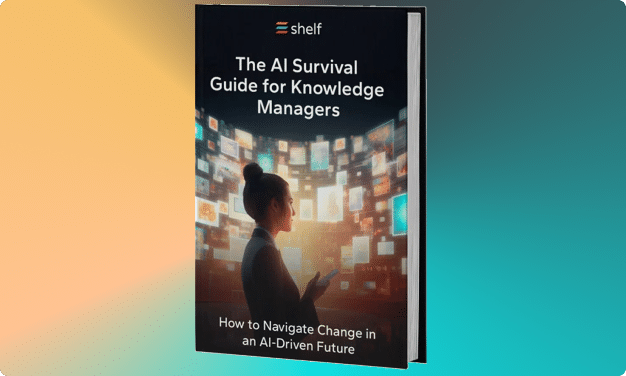When it comes to managing what your business knows, there’s a big difference between information and knowledge. You might hear terms like “information management” (IM) and “knowledge management” (KM) thrown around, and while they’re closely related, they play very different roles in how your organization operates, shares, and innovates.
Let’s dive into what sets these two apart, how they work together to make your organization smarter, and how you should use them.
Key Terms: Data, Information, and Knowledge
Before we dive into knowledge management vs. information management, we have to explain some key terms. These terms are often used interchangeably, but they actually have precise meanings.
Data refers to raw, unprocessed facts and figures. Think of data as individual, unstructured pieces, like numbers, words, or measurements that don’t carry meaning on their own. For example, “5,” “blue,” and “Monday” are all data points until context shapes them.
Information is data that has been organized, structured, or contextualized to provide meaning. When you process data, you turn it into information that can be used for decision-making. For instance, “5 blue cars were sold on Monday” is more meaningful because it provides context to the data points.
Knowledge is derived from processing, analyzing, and synthesizing information. It’s the insight, understanding, and actionable awareness that allows you to make informed decisions, solve problems, or take informed actions. Unlike data and information, organizational knowledge relies on experience, interpretation, and judgment to add context and depth.
What is Knowledge Management?
Knowledge management is the practice of capturing, organizing, sharing, and applying the collective knowledge within your organization. It involves creating processes and systems that allow individuals and teams to access and use critical information effectively.
The goal of a knowledge management strategy is to ensure the right knowledge reaches the right people at the right time. This helps you make informed decisions, solve problems faster. It can even drive innovation.
KM often focuses on transforming raw data and scattered information into actionable insights. This makes it easier to share expertise, reduce redundancy, and build an organizational culture of continuous learning. This approach requires both technology and human collaboration to improve how you gather, store, and distribute knowledge.
Why is Knowledge Management Important?
Knowledge management systems are vital for any organization that wants to harness its expertise and maintain a competitive edge. Here are the key reasons why KM is essential:
- Easy access to knowledge leads to better, faster decisions.
- Sharing knowledge across teams sparks creativity and new solutions.
- KM captures critical insights, preventing loss when employees leave.
- Quick access to information reduces time spent searching.
- Fewer repeated mistakes and less duplicated work.
- KM speeds up onboarding and skill-building.
- Fast, accurate answers enhance customer satisfaction.
- Ensures readiness for new challenges and changes.
Key Processes of Knowledge Management
Knowledge management uses several core processes to capture, share, and use knowledge effectively. Together, these processes let you manage knowledge strategically so it’s always available and useful to meet your goals.
Knowledge Discovery/Knowledge Creation
This process involves extracting new insights from data, documents, and other resources. It uses methods like data mining, pattern recognition, and analysis to find hidden relationships and valuable knowledge.
Knowledge Capture
Capturing knowledge means transforming what individuals know (tacit knowledge) into explicit formats that can be shared and stored. This often involves using knowledge management tools to document processes, create guides, or record expertise for future use.
Knowledge Sharing
Sharing knowledge makes sure it reaches those who need it. This process includes distributing knowledge through collaboration tools, meetings, knowledge bases, and internal networks, ensuring information flows seamlessly.

Knowledge Application
The ultimate goal of KM is to use tacit knowledge to perform tasks, make decisions, and solve problems. Applying what is known leads to improved processes, better customer service, and innovative products or solutions.
Shelf supports these key knowledge management processes through:
- AI-driven search and analytics uncover insights and patterns in data.
- Tools for documenting and converting tacit knowledge into shareable content.
- Collaborative platforms and knowledge bases ensure smooth distribution.
- Contextual delivery empowers decision-making, task execution, and innovation.
What is Information Management?
Information management is the practice of collecting, organizing, storing, and making information accessible throughout its lifecycle. It focuses on managing data and information so that it can be efficiently retrieved, shared, and used by the right people at the right time.
The goal of IM is to ensure that information remains useful for decision-making and your operational needs. This involves structuring data, applying rules and policies for access, and using technology for secure storage, sharing, and retrieval.
Unlike knowledge management, which emphasizes insight and expertise, IM deals with managing the raw and structured data that supports your organization’s operations.
Why is Information Management Important?
Information management makes sure that data is organized and accessible. This leads to better decision-making and overall efficiency. Here’s why it’s crucial:
- Ensures information is complete, consistent, and reliable.
- Organized data speeds up retrieval and sharing.
- Helps meet legal and regulatory requirements for data management.
- Streamlines data storage, minimizing redundancy and waste.
- Easy access to information fosters teamwork and knowledge sharing.
- Accurate, timely information improves service and support.
Key Processes of Information Management
Just like KM, information management involves several core processes that ensure data is organized, accessible, and useful throughout its lifecycle. Here are the key processes:
Information Collection
Gathering data from various sources, such as databases, documents, and external inputs, to create a comprehensive repository.
Information Organization
Structuring and categorizing data for easier retrieval, often through metadata tagging, categorization systems, and indexing methods.
Information Storage
Securing and storing data in systems that facilitate long-term accessibility, such as databases, cloud services, or physical archives.
Information Retrieval
Enabling quick and easy access to relevant data through search tools, indexing, and retrieval protocols.
Information Sharing and Distribution
Making information accessible to the right people through secure channels, collaboration tools, and dissemination platforms.
Information Maintenance and Archiving
Keeping data up-to-date, accurate, and relevant while archiving outdated or less-used information for historical reference or compliance.
Knowledge Management vs. Information Management Key Differences
While IM and KM are closely related, they serve distinct purposes within an organization. Let’s explore the differences to help you harness their unique strengths.
1. Focus and Purpose
IM centers on gathering, organizing, storing, and distributing structured and unstructured data. Its goal is to ensure that data remains accurate, accessible, and secure. It primarily deals with creating an efficient system for handling information.
KM focuses on transforming information and experience into actionable knowledge. It emphasizes capturing tacit (unwritten) expertise, sharing it, and applying it. KM is about empowering people with insights and fostering a culture of learning and collaboration.
2. Data vs. Insight
IM deals with data and structured content, organizing it into usable formats. The data might be numbers, documents, reports, or other structured elements that provide value when properly sorted and made accessible.
KM works with both structured and unstructured data but aims to generate context and meaning from that information. It turns insights into strategies and improves how you solve problems, make decisions, and innovate.

3. Storage and Access Methods
IM often relies on technology, such as databases, document management systems, and archives, to store and organize data. The focus is on creating a system that ensures data is accurate, secure, and readily accessible.
KM employs technology but also involves human processes, such as mentoring, knowledge-sharing sessions, and collaborative platforms. KM systems often use tools like knowledge bases, collaboration tools, and AI-driven search capabilities to distribute and share knowledge.
4. Static vs. Dynamic Use
IM treats information as a static resource. It ensures information is stored, preserved, and retrieved accurately. Changes are typically related to updating records, adding new entries, or modifying existing data without altering the core purpose of the data.
Knowledge management systems treat knowledge as a dynamic resource. It focuses on evolving insights and building upon existing information to drive innovation and improve performance. The knowledge is constantly recontextualized and adapted through interaction and collaboration.
5. Organizational Goals
The primary goal of IM is efficiency and security in data handling. IM helps you manage compliance, data accuracy, and efficient retrieval, reducing the time and cost associated with accessing and sharing information.
KM aims to enhance organizational learning, innovation, and adaptability. By sharing knowledge and fostering collaboration, KM enables you to adapt quickly to change, solve problems creatively, and drive continuous improvement.
6. Processes and Activities
Information management uses data collection, organization, and storage, access control and data security, data retrieval and distribution, and archiving and compliance.
Knowledge management deals with knowledge discovery and creation, capturing tacit and explicit knowledge, sharing knowledge through collaboration and communication tools, and applying knowledge to improve processes, products, and decision-making.
7. Tools and Technologies Used
IM relies on tools like data management systems, databases, file management solutions, and structured content storage systems. Knowledge management software includes a broad range of tools, including knowledge bases, AI-driven search, collaboration platforms, mentoring programs, and more.
8. Examples of Use Cases
Example use cases of information management: Managing customer data in a CRM system, organizing company policies in a document management system, or securing sensitive data to meet compliance standards.
Example use cases of knowledge management: Facilitating expert knowledge-sharing sessions, building a knowledge base for employee training, using AI to surface relevant insights from past projects.
Knowledge Management vs. Information Management Compared
| Information Management (IM) | Knowledge Management (KM) | |
| Focus and Purpose | Centers on gathering, organizing, storing, and distributing structured and unstructured data for accurate, accessible, and secure information management. | Focuses on transforming information and experience into actionable knowledge to improve decision-making, collaboration, and innovation. |
| Data vs. Insight | Deals with data and structured content, organizing it into usable formats such as numbers, documents, and reports. | Works with both structured and unstructured data, turning information into actionable insights, strategies, and improvements in problem-solving and innovation. |
| Storage and Access Methods | Relies on technology like databases, document management systems, and archives to store and organize data. | Employs both technology and human processes such as mentoring and collaborative platforms, using tools like knowledge bases and AI-driven search. |
| Static vs. Dynamic Use | Treats information as a static resource, focused on storage, preservation, and accurate retrieval. | Treats knowledge as a dynamic resource, constantly evolving and adapting through interaction and collaboration. |
| Organizational Goals | Aims for efficiency and security in data handling, focusing on compliance, data accuracy, and efficient retrieval to reduce time and cost. | Enhances organizational learning, innovation, and adaptability by fostering knowledge sharing and collaboration. |
| Processes and Activities | Data collection, organization, and storageAccess control and data securityData retrieval and distributionArchiving and compliance | Knowledge discovery and creationCapturing tacit and explicit knowledgeSharing knowledge through collaborationApplying knowledge to processes |
| Tools and Technologies Used | Relies on data management systems, databases, file management solutions, and structured content storage systems. | Knowledge management software uses a range of tools like knowledge bases, AI-driven search, collaboration platforms, and mentoring programs. |
| Examples of Use Cases | Managing customer data in a CRM systemOrganizing company policies in a document management systemSecuring sensitive data for compliance | Facilitating expert knowledge-sharing sessionsBuilding a knowledge base for trainingUsing AI to surface insights from past projects |
Knowledge Management vs. Information Management in Business
In business, information management and knowledge management work hand-in-hand, but they play different roles that impact how your organization operates and grows.
Information management is all about keeping things organized. Think of it as the system that gathers, stores, and makes data easy to access. When you need accurate reports, compliance records, or quick retrieval of important documents, IM has your back.
IM ensures data flows smoothly and securely, making sure everyone has the right information at their fingertips when they need it. Picture a well-organized filing system, but on a digital scale—it makes finding and using data efficient and reliable.
Knowledge management, however, takes things a step further. It turns that information into actionable knowledge. KM encourages people to share what they know, learn from one another, and build on past experiences. It thrives on collaboration—whether through team brainstorming, mentorship, or AI tools surfacing valuable insights from complex data.
In business, the best approach blends both. Information management lays a strong foundation by keeping your data in check and accessible, while knowledge management software builds on it to transform that data into meaningful insights and strategies.
For example, you might use IM to maintain a database of customer interactions. KM takes that data and figures out patterns, highlights what works, and shares those insights to improve customer service or develop new products.
When you get IM and KM working together, you create an environment where information flows seamlessly, and tacit knowledge fuels growth and innovation. That means less time hunting for data, more time making smarter decisions, and a workplace of continuous learning and improving.
Knowledge and Information Together
Information and knowledge management are like two sides of the same coin—they need each other to thrive. While information management builds a strong foundation by organizing and storing data, knowledge management turns that data into insights, innovation, and growth.
By understanding their differences and strengths, you can create a system that not only keeps your data in check but also empowers your team to learn, share, and act with confidence. Together, IM and KM make your organization more adaptable, collaborative, and ready to face whatever comes next.




